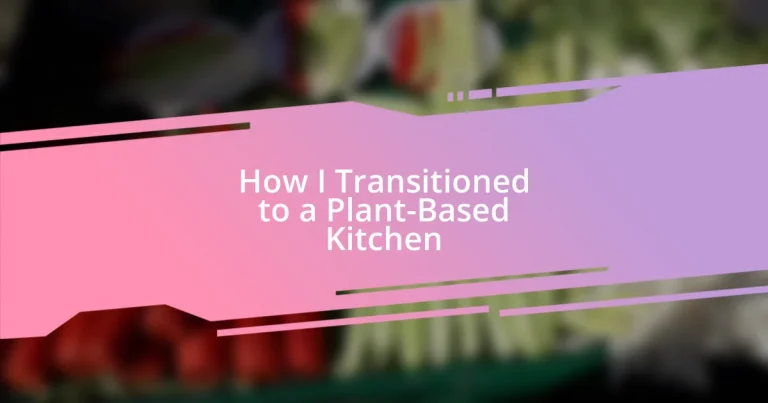Key takeaways:
- Transitioning to a plant-based kitchen significantly enhances energy levels and emotional well-being, fostering a deeper connection between food and feelings.
- Assessing pantry staples, fresh produce, and cooking tools is crucial for effective transitioning, allowing for better planning and organization.
- Overcoming challenges, such as finding substitutes and dealing with cravings, can lead to creative culinary solutions and unexpected connections in social settings.

Understanding Plant-Based Benefits
One of the most eye-opening benefits of embracing a plant-based kitchen is the remarkable shift in my energy levels. After transitioning, I noticed I felt lighter and more vibrant, almost as if a fog had lifted. Have you ever experienced that midday slump that feels like a weight on your shoulders? I used to, but replacing heavy meals with nourishing, colorful plant dishes turned that all around for me.
Another significant aspect I’ve come to appreciate is how plant-based eating can be incredibly rewarding for our emotional health. I remember the first time I cooked a hearty lentil stew packed with spices; it was not just nourishing but also soul-soothing. It made me think—how often do we associate cooking with love and care? The connection between food and our feelings became crystal clear; preparing meals from fresh fruits and vegetables brought joy and mindfulness into my daily routine.
Of course, there’s also the undeniable impact on the environment that resonates deeply with me. Each time I opt for a plant-based meal, I feel that I’m contributing to a larger cause. What’s more fulfilling than knowing that my plate can help reduce carbon footprints and promote sustainability? I often reflect on how interconnected our choices are with the well-being of our planet, and it’s a powerful realization that drives me to continue this journey.

Assessing Your Current Kitchen
To effectively transition to a plant-based kitchen, it first requires a close look at what you currently have. I remember the day I opened my pantry and really evaluated the ingredients I was holding onto. I found various items that I hadn’t used in ages—canned soups with mystery ingredients and a stash of rice that seemed to multiply. Taking stock helped me realize not just what I needed but also what I could let go of, creating space for vibrant new foods.
When assessing your kitchen, consider these key areas:
- Pantry Staples: Identify any processed foods or items high in sugar and sodium.
- Fresh Produce: Check your fridge for fruits and vegetables; are they fresh and inspiring?
- Condiments & Oils: Consider whether your oils and sauces align with plant-based cooking.
- Storage Solutions: Ensure you have ample space to store fresh ingredients, like glass containers for grains and legumes.
- Cookware: Assess if you have the right tools; cast iron skillets and steamers can make a world of difference.
Evaluating these facets can be an eye-opening experience and a catalyst for change. Each item you decide to keep or replace paves the way for the exciting culinary adventures that lie ahead.

Setting Realistic Plant-Based Goals
Setting realistic plant-based goals is crucial in making a sustainable switch. Initially, I started by adopting one plant-based meal a day. It felt manageable and allowed me to explore a variety of flavors without feeling overwhelmed. Have you ever found it easier to take small steps rather than huge leaps? That’s how I approached my transition, slowly incorporating different recipes that not only tantalized my taste buds but also kept me excited about my culinary journey.
As I progressed, I set monthly challenges to deepen my commitment. For instance, one month I focused solely on trying new grains like quinoa and farro—both versatile and delicious. I can still recall the joy of discovering wholesome grain bowls topped with roasted veggies. In fact, I often looked forward to these challenges as they became mini-adventures, spurring creativity in my kitchen. How can you keep your own journey fresh and enjoyable? Setting time-bound goals can be a motivating factor, pushing us to think outside the box while we develop new habits.
It’s also important to remember that setbacks are part of the process. I learned this through a week when life got busy, and I resorted to old habits. Instead of feeling guilty, I treated it as a learning experience, helping me identify where I needed better planning or preparation. Reflecting on my journey has ingrained the idea that flexibility contributes to long-term success, so resilience is vital when setting and revisiting goals.
| Goal Setting Aspect | Example |
|---|---|
| Daily Meal Inclusion | One plant-based meal per day |
| Monthly Challenges | Try a new grain each month |
| Flexibility in Planning | Adjust goals based on lifestyle changes |

Essential Pantry Staples to Stock
When I first transitioned to a plant-based kitchen, I realized that certain pantry staples were absolutely crucial. Whole grains like brown rice, quinoa, and oats quickly became my go-to bases, providing the energy and nutrients I needed. I vividly recall the first time I cooked with farro; its chewy texture and nutty flavor transformed a basic veggie dish into something almost gourmet.
Legumes are another must-have. I love stocking up on canned beans and lentils. They are not only convenient but also packed with protein and fiber. There was a time when I forgot to include them in my meals, and I could really feel the difference. Now, a simple chickpea salad can be a satisfying lunch that leaves me energized for the rest of the day. Aren’t they an amazing time-saver when you’re in a rush?
Don’t forget about spices and herbs. They can make even the simplest dish pop with flavor. I remember feeling overwhelmed by the number of options at the store, but I narrowed it down to a few key favorites—cumin, paprika, and turmeric—each with their unique benefits and tones. With just a sprinkle of these, a basic stir-fry can become a vibrant melody of flavors. Have you ever thought about how just a handful of spices can redefine your cooking? Mastering these essentials has truly helped me enjoy my meals while sticking to my plant-based lifestyle.

Cooking Techniques for Plant-Based Meals
When I think about cooking techniques for plant-based meals, one method that stands out is roasting. I remember the first time I intentionally roasted a medley of vegetables, and I was simply taken aback by the flavor transformation. Just placing carrots, bell peppers, and zucchini in the oven—not only did the smell fill my kitchen, but the caramelization brought out those sweet, earthy flavors that made each bite satisfying. Have you experienced the magic of roasting?
Another technique that has significantly elevated my dishes is sautéing with an array of spices. I can still feel the excitement of my first stir-fry, where a simple mix of garlic, ginger, and soy sauce turned a bunch of veggies into a vibrant, aromatic feast. Now, I often play with various spice blends to discover new flavor profiles. It’s surprisingly rewarding to toss in leftover vegetables and watch them transform into something exciting! How often do you find yourself experimenting in the kitchen? I have learned that adding a dash of creativity can lead to delightful surprises.
Lastly, I cannot emphasize enough the role of blending in my plant-based cooking. I once made a creamy, dreamy butternut squash soup purely from blending roasted squash, a hint of coconut milk, and vegetable broth. The smooth texture was just like a warm hug in a bowl. Using a blender opens up possibilities for sauces, dips, and smoothies too. Isn’t it incredible how just a few ingredients can lead to so many culinary adventures? I’m always on the lookout for new blends that can bring joy to my kitchen creations.

Overcoming Challenges in Transitioning
Transitioning to a plant-based kitchen certainly came with its hurdles. For instance, I encountered the challenge of finding adequate substitutes for familiar ingredients. I vividly remember standing in front of the dairy aisle, longing for the creamy textures of my favorite cheeses. It took time and experimentation, but discovering nut-based cheeses and cashew creams ultimately turned that longing into delight. Have you ever found joy in unexpected substitutes?
Another significant challenge was overcoming cravings for my former comfort foods. One evening, I craved a rich, cheesy pasta dish. Instead of feeling defeated, I decided to create a cashew-based Alfredo sauce. The process of blending soaked cashews with garlic, lemon juice, and nutritional yeast was surprisingly exhilarating. When I finally tasted my creation, I couldn’t believe how creamy and indulgent it was! Have you found that sometimes your cravings can lead to discovering an even better alternative?
Social situations added another layer of complexity. I recall a dinner invite where the menu was decidedly non-plant-based. I felt a bit anxious thinking about what I’d eat, while everyone else savored their meals. Instead of shying away, I prepared a vibrant quinoa salad brimming with veggies and a tangy dressing. To my surprise, my dish became a conversation starter; everyone’s curiosity turned into compliments! Isn’t it amazing how facing challenges head-on can lead to unexpected connections?














